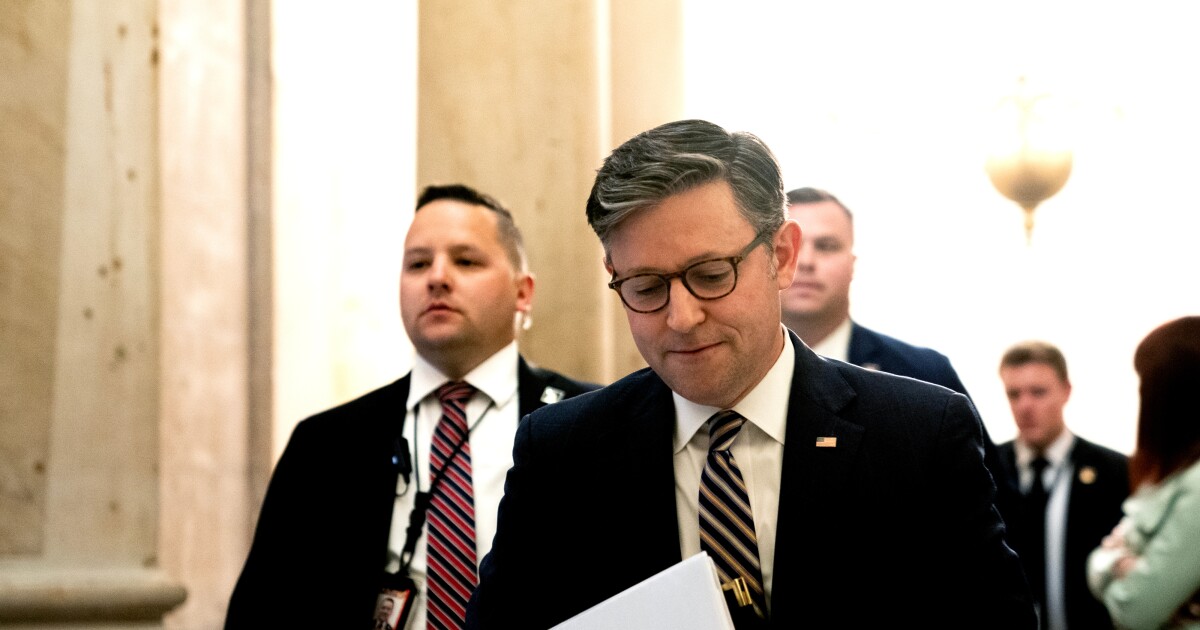The cost of Republican lawmakers’ draft plan for sweeping tax cuts weighed in at $3.8 trillion over the next 10 years in one official estimate. The reality is likely much higher, thanks to the use of budget and political tools designed to minimize the appearance of the fiscal hit, according to independent analysts including former Republican staff members.
Budget experts typically calculate the cost of legislation, or “score,” over a 10-year period. But President Donald Trump’s headline-grabbing pledges to remove taxes on tips and overtime are supposed to expire after just four years in the latest bill. That has the effect of downplaying the potential revenue loss if the measures are extended — which Congress has a tendency to do.
It could also raise concerns among investors and economists about the scale of future borrowing needs for a government whose debt load is on track to surpass 118% of the economy’s size by 2035, potentially undermining confidence in U.S. securities.
Republicans are quick to defend the size of the tax cuts, saying they will grow the economy and, with Trump’s tariff policies, bring in trillions of dollars of added revenue to federal coffers — along with savings found by the Elon Musk-led Department of Government Efficiency.
Speaker Mike Johnson is aiming to secure House approval later this month for a bill that, along with providing Trump’s new benefits, makes permanent the lower income-tax rates set in Trump’s 2017 package. Those rates had been scheduled to expire at the end of this year — something that had limited the official cost of that package in Trump’s first term.
Analysis by the Committee for a Responsible Federal Budget, a centrist fiscal watchdog group, shows that extending the new benefits for a full decade would take the cumulative increase in the deficit to $5.2 trillion. That compares with an official congressional Joint Committee on Taxation tally of $3.8 trillion. After factoring in spending cuts in Medicaid and other items, the CRFB estimated the deficit boost at $3.3 trillion.
While both Republicans and Democrats have previously used budget tricks to portray a better fiscal impact, the scale of the potentially hidden effects of the GOP tax package is striking, said Marc Goldwein, senior policy director at the CRFB.
“The entire reason they did this temporarily was to reduce this cost,” Goldwein said. “They are basically trying to hide” the additional costs, he said.
Trump and his cabinet members have argued that official scoring fails to capture hundreds of billions of dollars of future revenue from increased tariffs. They also claim that the administration’s deregulatory agenda will lift burdens on businesses, boosting growth.
“It’s going to go gangbusters,” Jason Smith, the GOP chair of the tax-writing House Ways and Means Committee, said of the economy after the tax bill is enacted. Speaking at an Economic Club of Washington, D.C. event Thursday, he cited measures including 100% expensing of certain business investments and incentives for building factories, along with a lower burden on so-called pass-through businesses. There’ll be a “huge impact to the economy,” he said.
GOP’s argument
Smith also claimed that the $1.5 trillion of spending cuts penciled in for the bill, if followed through on, would be the largest reduction of any bill in legislative history. He disputed critics saying tax cuts will balloon the deficit, arguing that spending is the problem.
Federal revenue makes up about the same share of GDP now, at around 17%, as its average over the past 50 years, and most of the current bill simply extends current tax laws, Smith said.
The combination of Trump’s tax cuts, savings and deregulation means a more likely deficit impact of below $2 trillion over the coming decade, Richard Stern, a fiscal expert at the Heritage Foundation, a conservative-leaning think tank.
“The spending cuts are not going to hold back growth — they are not cutting critical services or going to hold back business flows,” Stern said. “These are cutting largely wasteful and fraudulent spending.”
Unsustainable path
Even without adding to U.S. borrowing needs, the existing run rate has the federal debt burden on a trajectory that most observers, including Treasury Secretary Scott Bessent, view as unsustainable. Annual deficits have been clocking near $2 trillion in recent years, or more than 6% of gross domestic product.
The debt-to-GDP ratio is heading for a record high in just four years’ time, according to the nonpartisan Congressional Budget Office.
Trump has dubbed the legislation, which includes a slew of spending reductions yet to be specified in detail, “one big, beautiful bill.” Barclays Plc economists on Wednesday titled a research note on the topic, “One big, beautiful” deficit. “Investors in longer U.S. bonds are unlikely to be happy,” they wrote.
By the calculation of G. William Hoagland at the Bipartisan Policy Center, sunsetting many of Trump’s new benefits after four years, the tax bill saved roughly $500 billion.
The draft bill has a deduction for senior citizens sunsetting in four years, with an expanded child tax credit of $2,500 ending Dec. 31, 2028.
“This is an old trick the tax writers do,” Hoagland, a former congressional Republican staff member, said of phasing out a benefit. “From a fiscal perspective, it underestimates the real cost of these bills.”
Rohit Kumar, national tax office co-leader at PricewaterhouseCoopers LLP and a former top Senate policy aide, said that if provisions prove “super popular, whoever’s running for president in 2028 can run on renewing them.”
The other way lawmakers tried to cut the bill’s cost was “to put the guardrails around who qualifies,” Kumar added. This included adding income limits for a new deduction aimed at retirees, as well as detailing which industries were eligible for the no-tax-on-tips provision.
Ultimately, the four-year timeline for when the tax cuts expire will only stoke uncertainty for both businesses and individuals, said Goldwein at the CRFB.
“How can you plan around a tax code when large parts of it expire in four years,” he said.


 Personal Finance6 days ago
Personal Finance6 days ago
 Personal Finance1 week ago
Personal Finance1 week ago
 Personal Finance6 days ago
Personal Finance6 days ago
 Economics1 week ago
Economics1 week ago
 Economics1 week ago
Economics1 week ago
 Economics1 week ago
Economics1 week ago
 Economics1 week ago
Economics1 week ago
 Economics1 week ago
Economics1 week ago












